过去分词与现在分词的区别
浅析现在分词和过去分词的区别

3 . 从 时 态 上 区 别
及 物 动词 和 不 及 物 动 词 的现 在 分 词 .都 表 示 正 在 进 行 的 动作。 及 物 动 词 的过 去 分 词 表 示 已经 完 成 的 动 作 。 不 及 物 动 词 的 过去 分 词 只表 示 完 成 , 不表示被动 。
C h i n a i s a d e v e l o p i n g c o u n t r y a n d Ame r i c a i s a d e v e现在分词作宾语补足语时 , 与 句 子 的 宾 语 逻 辑 上 是 主 动关系 。 表示动作正在进行 、 还 未 结 束 或 持续 进 行 。
We f o u n d t h e m s t a n d i n g t h e r e , u n a b l e t o i f n d a n y h e l p . D o n’ t h a v e y o u r c h i l d r e n w o r k h a r d a t t h e i r h o me wo r k a l l t h e
c o un t r y .
( 1 ) 分词及分词短语可作时间状语 、 原 因状 语 、 条件状语 、 结 果 状语 、 让步状语 、 或 伴 随 状语 。 分 词 作 状语 相 当 于 一 个 状 语从句。 He a r i n g t h e b a d n e ws .t h e y c o u l d n’ t h e l p c r y i n g .( 时 间 状
浅 析 现 在 分 词 和 过 去 分 词 的 区 别
成 明珠
( 永 登 县 西 铁 中学 , 甘肃 永登 7 3 0 3 0 0 )
现 在 分 词 和 过 去 分 词 的 用 法 是 高 中 阶 段 学 生 必 须 掌 握 的 语法 内容 。 它们 在高 中 阶段 的 阅读 中 出现 率 非 常 高 , 常 常 会 困 扰 学 生 对 出 现 现 在 分 词 或 者 过 去 分 词 的句 子 的 正确 理 解 。 现 在 分 词 和 过去 分词 形式 上 的 区别
现在分词和过去分词的区别

过去分词作表语
描述主语的状态或信仰,如 "I am convinced."
现在分词作状语
时间
Using Facebook every morning is his habit.
原因
Feeling bored, she passed the time by making pizza.
方式
The cowboy crossed the plain riding his horse.
过去分词作定语
被动语态
The lost ball was found behind the couch.
描述状态
The broken pencil cannot be used.
描述感受
The frightened deer ran away immediately.
过去分词作表语
1 描述状态
2 描述感受
3 描述事件结果
The flowers are wilted.
I was thrilled with the gift.
The job was done.
构成方式
1
现在分词
大多数动词加 -ing,但有一些变化,如双写结尾的词,或结尾为 -ie 的动词变为 -ying。
2
过去分词
大多数动词加 -ed 结尾,但是一些动词有它们自己的形式。也有其他表示过去的 形式,如- d 或 -t。
3
不规则动词
有些动词的现在分词和过去分词是相同的形式,如 cut 和 put。
用法区别
现在分词作定语
描述正在发生的动作,如 “the running man”。
现在分词作状语
描述一个动作发生的时间、原因、方式等, 如 "Walking slowly, he enjoyed the breeze."
现在分词和过去分词的区别
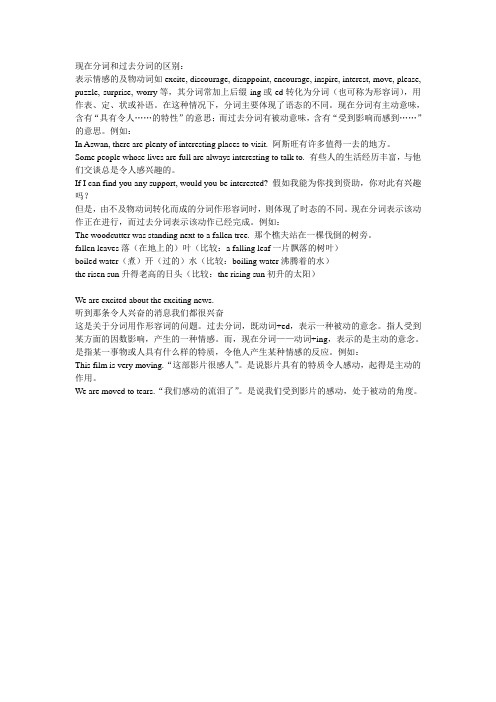
现在分词和过去分词的区别:表示情感的及物动词如excite, discourage, disappoint, encourage, inspire, interest, move, please, puzzle, surprise, worry等,其分词常加上后缀-ing或-ed转化为分词(也可称为形容词),用作表、定、状或补语。
在这种情况下,分词主要体现了语态的不同。
现在分词有主动意味,含有“具有令人……的特性”的意思;而过去分词有被动意味,含有“受到影响而感到……”的意思。
例如:In Aswan, there are plenty of interesting places to visit. 阿斯旺有许多值得一去的地方。
Some people whose lives are full are always interesting to talk to. 有些人的生活经历丰富,与他们交谈总是令人感兴趣的。
If I can find you any support, would you be interested? 假如我能为你找到资助,你对此有兴趣吗?但是,由不及物动词转化而成的分词作形容词时,则体现了时态的不同。
现在分词表示该动作正在进行,而过去分词表示该动作已经完成。
例如:The woodcutter was standing next to a fallen tree. 那个樵夫站在一棵伐倒的树旁。
fallen leaves落(在地上的)叶(比较:a falling leaf一片飘落的树叶)boiled water(煮)开(过的)水(比较:boiling water沸腾着的水)the risen sun升得老高的日头(比较:the rising sun初升的太阳)We are excited about the exciting news.听到那条令人兴奋的消息我们都很兴奋这是关于分词用作形容词的问题。
现在分词和过去分词的区别
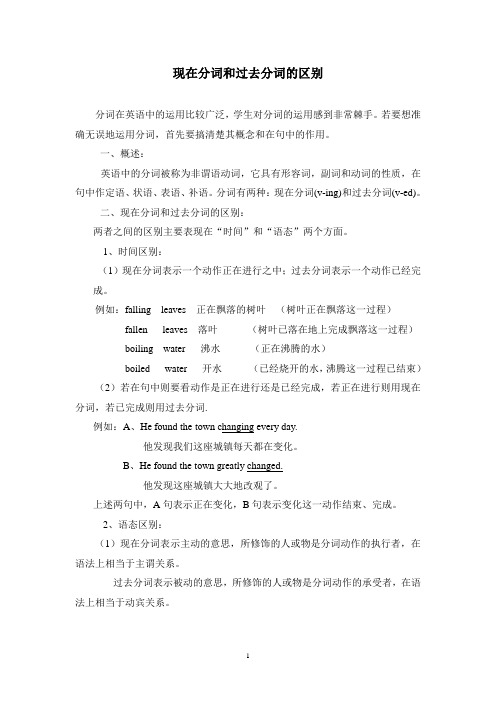
现在分词和过去分词的区别分词在英语中的运用比较广泛,学生对分词的运用感到非常棘手。
若要想准确无误地运用分词,首先要搞清楚其概念和在句中的作用。
一、概述:英语中的分词被称为非谓语动词,它具有形容词,副词和动词的性质,在句中作定语、状语、表语、补语。
分词有两种:现在分词(v-ing)和过去分词(v-ed)。
二、现在分词和过去分词的区别:两者之间的区别主要表现在“时间”和“语态”两个方面。
1、时间区别:(1)现在分词表示一个动作正在进行之中;过去分词表示一个动作已经完成。
例如:falling leaves 正在飘落的树叶(树叶正在飘落这一过程)fallen leaves 落叶(树叶已落在地上完成飘落这一过程)boiling water 沸水(正在沸腾的水)boiled water 开水(已经烧开的水,沸腾这一过程已结束)(2)若在句中则要看动作是正在进行还是已经完成,若正在进行则用现在分词,若已完成则用过去分词.例如:A、He found the town changing every day.他发现我们这座城镇每天都在变化。
B、He found the town greatly changed.他发现这座城镇大大地改观了。
上述两句中,A句表示正在变化,B句表示变化这一动作结束、完成。
2、语态区别:(1)现在分词表示主动的意思,所修饰的人或物是分词动作的执行者,在语法上相当于主谓关系。
过去分词表示被动的意思,所修饰的人或物是分词动作的承受者,在语法上相当于动宾关系。
例如:①a moving film.一部感人的影片。
(影片内容感动)= a film moves people.(主谓关系)S V②the moved students. 受感动的学生们= the Ss are moved by ……(动宾→宾语被置于主语的位置,采用被动的语态)S V(2)若在句中,则要看与全句的主语或其逻辑主语之间的关系,是主动用现在分词,若为被动,则要用过去分词。
现在分词与过去分词的区别

现在分词与过去分词的区别:1,语态上不同:现在分词表主动,而及物动词的过去分词表被动.2,时间关系上不同:现在分词表正在进行的动作,过去分词表示已经过去的动作.3,选用现在分词还是过去分词取决于分词所表示的动作与逻辑主语之间的时间关系.分词短语作状语,其逻辑主语是句子的主语.分词的形式:以vt:write和vi:go为例,1,现在分词:主动语态writing 被动语态being written 主动语态going2,过去分词: 只有一种形式 written gone现在分词和过去分词主要的区别表现在语态和时间关系上。
1)语态上不同:现在分词表示主动的意思,而过去分词多由及物动词变来,表示被动的意思。
试比较:surprising 使人感到惊讶的(主动)surprised 自己感到惊讶的(被动,即被惊讶的)an exciting story 一个令人兴奋的故事(主动)excited spectators 激动的观众(被动,即被引起激动的)a moving film 一部感动人的影片。
A moved audience 受感动的观众A tiring journey 累人的旅行A tired football player 累了的足球运动员He told us many interesting things last night.他昨夜告诉我们许多有趣的事情。
She is interested in astronomy. 她对天文学有兴趣。
也有一些过去分词是由不及物动词变来的,它们只表示一个动作已完成,没有被动的意味。
如:the risen sun 升起的太阳fallen leaves 落叶the exploded bomb 已爆炸了的炸弹a retired miner 退休矿工returned students 归国留学生2)时间关系上不同:一般说来,现在分词所表示的动作往往正在进行,而过去分词所表示的动作,往往已经完成。
现在分词与过去分词的区别与用法解析
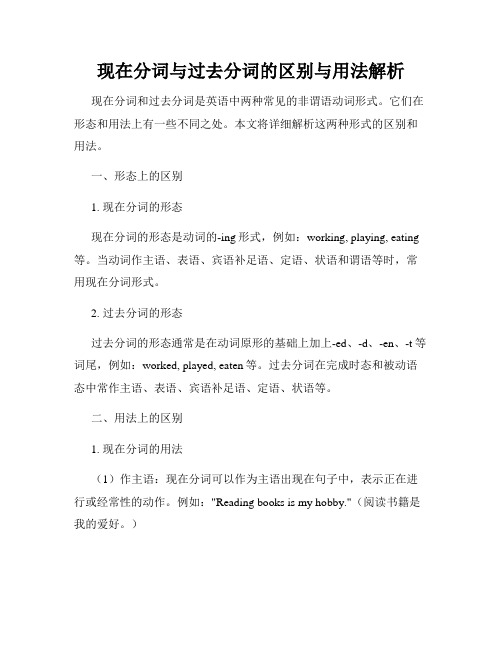
现在分词与过去分词的区别与用法解析现在分词和过去分词是英语中两种常见的非谓语动词形式。
它们在形态和用法上有一些不同之处。
本文将详细解析这两种形式的区别和用法。
一、形态上的区别1. 现在分词的形态现在分词的形态是动词的-ing形式,例如:working, playing, eating 等。
当动词作主语、表语、宾语补足语、定语、状语和谓语等时,常用现在分词形式。
2. 过去分词的形态过去分词的形态通常是在动词原形的基础上加上-ed、-d、-en、-t等词尾,例如:worked, played, eaten等。
过去分词在完成时态和被动语态中常作主语、表语、宾语补足语、定语、状语等。
二、用法上的区别1. 现在分词的用法(1)作主语:现在分词可以作为主语出现在句子中,表示正在进行或经常性的动作。
例如:"Reading books is my hobby."(阅读书籍是我的爱好。
)(2)作定语:现在分词可以修饰名词作定语,常表示主动、进行或经常性的动作。
例如:"The running water is very clear."(流动的水非常清澈。
)(3)作宾语补足语:现在分词可以作及物动词的宾语补足语,表示正在进行或经常性的动作。
例如:"I saw him painting the house."(我看见他正在刷房子。
)2. 过去分词的用法(1)作主语:过去分词可以作为主语出现在句子中,表示完成的动作或状态。
例如:"Broken glass covered the ground."(破碎的玻璃铺满了地面。
)(2)作定语:过去分词可以修饰名词作定语,表示被动或完成的动作。
例如:"The lost key has been found."(丢失的钥匙已经找到了。
)(3)作宾语补足语:过去分词可以作及物动词的宾语补足语,表示完成的动作或状态。
现在分词与过去分词的区别

现在分词与过去分词的主要区别现在分词和过去分词主要的区别表现在语态和时间关系上。
笔者想结合分词在定语、补语、状语及独立主格结构中的用法谈谈现在分词与过去分词的主要区别。
一、现在分词与过去分词当定语现在分词与过去分词当定语的区别首先表现在被修饰词与现在分词之间是主动关系,过去分词当定语时被修饰的词与分词之间则是被动关系。
单个分词作定语通常置于被修饰词之前,分词短语则要后置。
例如:The president made an inspiring speech(= which was inspiring)at the meeting.总统在会上作了令人鼓舞的演说。
The man sitting (= who is sitting) at the desk is his secretary. 坐在桌旁那个人是他的秘书。
The moved children (= who were moved) were determined to work harder at their lessons.受感动的孩子们决心更加努力地学习功课。
She showed me the book recommended by the professor (=which was recommended ).她把教授推荐的书给我看了看。
现在分词与过去分词当定语的另一个区别是现在分词表示动作正在进行,过去分词则表示动作已经完成。
例如:It is well known that China belongs to a developing country.众所周知,中国属于发展中国家。
We are determined to work harder so as to catch up with the developed countries.我们决心更加努力工作以便赶上发达国家。
不及物动词的过去分词只表示动作完成,没有被动含义。
I was watching the risen moon on the balcony when the telephone rang.我正在阳台上看升起了的月亮突然间电话铃响了。
现在分词和过去分词的用法区别
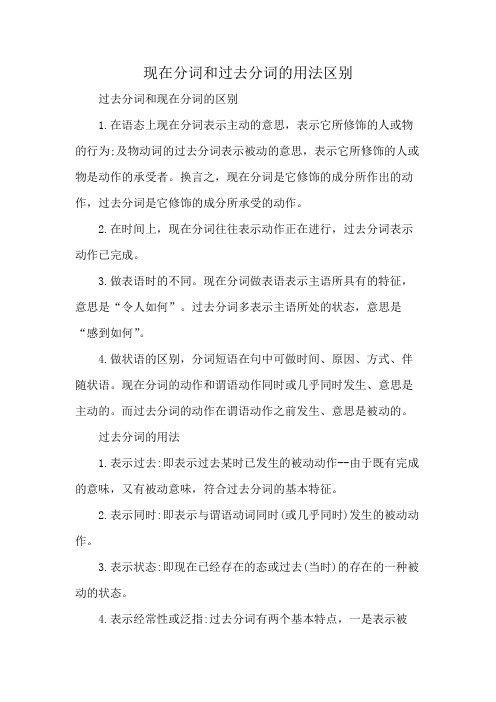
现在分词和过去分词的用法区别
过去分词和现在分词的区别
1.在语态上现在分词表示主动的意思,表示它所修饰的人或物的行为;及物动词的过去分词表示被动的意思,表示它所修饰的人或物是动作的承受者。
换言之,现在分词是它修饰的成分所作出的动作,过去分词是它修饰的成分所承受的动作。
2.在时间上,现在分词往往表示动作正在进行,过去分词表示动作已完成。
3.做表语时的不同。
现在分词做表语表示主语所具有的特征,意思是“令人如何”。
过去分词多表示主语所处的状态,意思是“感到如何”。
4.做状语的区别,分词短语在句中可做时间、原因、方式、伴随状语。
现在分词的动作和谓语动作同时或几乎同时发生、意思是主动的。
而过去分词的动作在谓语动作之前发生、意思是被动的。
过去分词的用法
1.表示过去:即表示过去某时已发生的被动动作--由于既有完成的意味,又有被动意味,符合过去分词的基本特征。
2.表示同时:即表示与谓语动词同时(或几乎同时)发生的被动动作。
3.表示状态:即现在已经存在的态或过去(当时)的存在的一种被动的状态。
4.表示经常性或泛指:过去分词有两个基本特点,一是表示被
动,二是表示完成。
现在分词的用法
1.现在分词的一般式所表示的动作与主语动作同时发生。
2.当要表示一个被动动作时,现在分词就用被动形式。
3.分词的否定式总是将否定词not置于分词之前,遇上现在分词的完成式、被动式以及完成被动式,否定词应置于整个结构之前。
现在分词与过去分词的差别
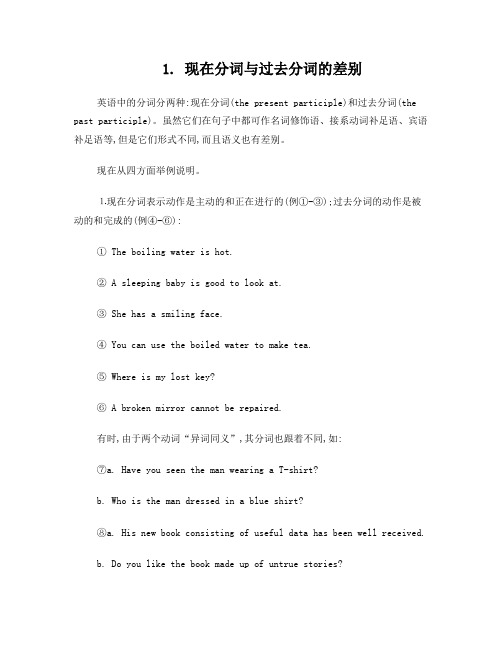
1. 现在分词与过去分词的差别英语中的分词分两种:现在分词(the present participle)和过去分词(the past participle)。
虽然它们在句子中都可作名词修饰语、接系动词补足语、宾语补足语等,但是它们形式不同,而且语义也有差别。
现在从四方面举例说明。
⒈现在分词表示动作是主动的和正在进行的(例①-③);过去分词的动作是被动的和完成的(例④-⑥):① The boiling water is hot.② A sleeping baby is good to look at.③ She has a smiling face.④ You can use the boiled water to make tea.⑤ Where is my lost key?⑥ A broken mirror cannot be repaired.有时,由于两个动词“异词同义”,其分词也跟着不同,如:⑦a. Have you seen the man wearing a T-shirt?b. Who is the man dressed in a blue shirt?⑧a. His new book consisting of useful data has been well received.b. Do you like the book made up of untrue stories?⒉在语义上,现在分词和过去分词反映的心理状态不同。
前者有“令人……”的含义(见例⑨);过去分词则有“感到……”的意思(见例⑩):⑨ The soccer match last night was thrilling.(令人紧张)⑩ The soccer fans were delighted.(感到高兴)其他例子有:● amazing: amazed● annoying: annoyed● boring: bored● confusing: confused● surprising: surprised● terrifying: terrified试比较11a和b以及12a和b:11a. This is the most confusing system I have ever seen.11b. The children will get confused if asked to learn too much at a time.12a. David came with some surprising news.12b. All were surprised at Sam’s sudden resignation.⒊在作宾语补足语时,如果宾语是有关分词逻辑上的主语,就用现在分词,如 :13. The teacher found a student dozing off.14. Don’t keep the visitor waiting.如果宾语和有关分词有“动词+宾语”关系,那么这个分词就要是过去分词了,如:15. Where did you get your book printed?16. You should have your office whitewashed.在13里,正在打瞌睡的是宾语“a studen t“;在14里,宾语是“the visitor”。
中考英语 现在分词和过去分词的区别

【小艺点睛】现在分词和过去分词的区别:在语态上,现在分词表示主动意义,过去分词表示被动意义;在时间上,现在分词表示的动作往往正在进行或者与谓语动词同时发生,过去分词表示的动作已经完成或没有一定的时间性。
如:falling leaves 正在下落的树叶fallen leaves 已经落在地上的树叶分词的作用1、作定语(1)单个分词作定语,分词前置。
如:The sleeping boy is my son.The excited people rushed into the building.(2)分词短语作定语,分词后置;分词修饰不定代词something等要后置;个别分词如give,left等作定语也后置。
如:The girl standing under the tree is my niece.The building built last year is our library.(3)过去分词作定语与其修饰的词是被动关系,相当于一个被动语态的定语从句。
如:Most of the people invited to the party were famous scientists.2、作状语现在分词和过去分词在句中可以作时间、原因、方式、伴随、条件、结果等状语。
Not receiving any letter from him, I gave him a call.(原因)Given more attention, the trees could have grown better. (条件)Bitten by a snake, he was taken to hospital. (原因)Though defeated, he didn’t lose heart. (让步)He lay on the grass, looking into the sky. (伴随)He came running to tell me the good news. (方式)注意:主要用于作状语,一般不用作定语。
过去分词与现在分词的区别
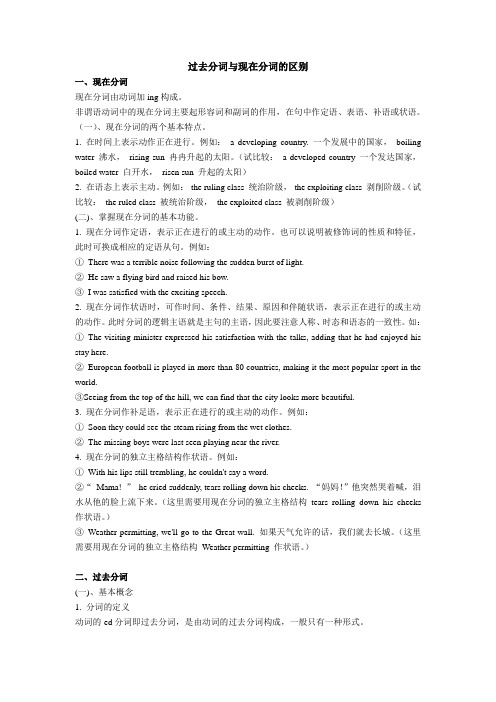
过去分词与现在分词的区别一、现在分词现在分词由动词加ing构成。
非谓语动词中的现在分词主要起形容词和副词的作用,在句中作定语、表语、补语或状语。
(一)、现在分词的两个基本特点。
1. 在时间上表示动作正在进行。
例如:a developing country. 一个发展中的国家,boiling water 沸水,rising sun 冉冉升起的太阳。
(试比较:a developed country 一个发达国家,boiled water 白开水,risen sun 升起的太阳)2. 在语态上表示主动。
例如:the ruling class 统治阶级,the exploiting class 剥削阶级。
(试比较:the ruled class 被统治阶级,the exploited class 被剥削阶级)(二)、掌握现在分词的基本功能。
1. 现在分词作定语,表示正在进行的或主动的动作。
也可以说明被修饰词的性质和特征,此时可换成相应的定语从句。
例如:①There was a terrible noise following the sudden burst of light.②He saw a flying bird and raised his bow.③I was satisfied with the exciting speech.2. 现在分词作状语时,可作时间、条件、结果、原因和伴随状语,表示正在进行的或主动的动作。
此时分词的逻辑主语就是主句的主语,因此要注意人称、时态和语态的一致性。
如:①The visiting minister expressed his satisfaction with the talks, adding that he had enjoyed his stay here.②European football is played in more than 80 countries, making it the most popular sport in the world.③Seeing from the top of the hill, we can find that the city looks more beautiful.3. 现在分词作补足语,表示正在进行的或主动的动作。
现在分词和过去分词的区别
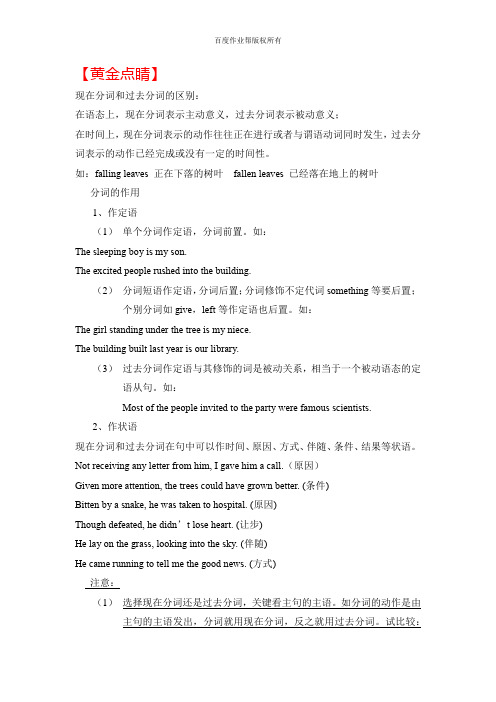
【黄金点睛】现在分词和过去分词的区别:在语态上,现在分词表示主动意义,过去分词表示被动意义;在时间上,现在分词表示的动作往往正在进行或者与谓语动词同时发生,过去分词表示的动作已经完成或没有一定的时间性。
如:falling leaves 正在下落的树叶fallen leaves 已经落在地上的树叶分词的作用1、作定语(1)单个分词作定语,分词前置。
如:The sleeping boy is my son.The excited people rushed into the building.(2)分词短语作定语,分词后置;分词修饰不定代词something等要后置;个别分词如give,left等作定语也后置。
如:The girl standing under the tree is my niece.The building built last year is our library.(3)过去分词作定语与其修饰的词是被动关系,相当于一个被动语态的定语从句。
如:Most of the people invited to the party were famous scientists.2、作状语现在分词和过去分词在句中可以作时间、原因、方式、伴随、条件、结果等状语。
Not receiving any letter from him, I gave him a call.(原因)Given more attention, the trees could have grown better. (条件)Bitten by a snake, he was taken to hospital. (原因)Though defeated, he didn’t lose heart. (让步)He lay on the grass, looking into the sky. (伴随)He came running to tell me the good news. (方式)注意:(1)选择现在分词还是过去分词,关键看主句的主语。
现在分词与过去分词的区别

3.分词作宾语补足语
现在分词在see, watch, hear, observe, notice, feel, find, glimpse, glance等感官动词和look at, listen to等短语动词以及have, keep, get, catch, leave, set, start, send等使役 动词后面与名词和代词构成复合宾 语,作宾语补语的成分。
A ,the museum will be open to the 4. When _ public next year. A. completed B. completing C. being completed D. to be completed B to his research, he almost forgot 5. _ everything. A. Devoting B. Devoted C. To devote D. Devote
例如
1、On the top of the hill, we could see smoke rising from the chimneys in the village. 2、The boy sat beside the railway line and watched the trains roaring by. 3、We should not leave him wondering what he should do. 4、I am sorry to have kept you waiting for such a long time. 5、I caught him doing something else in class.
◆ The result of the test is
现在分词与过去分词的区别课件

06
现在分词与过去分词的语义差异
现在分词的语义特征
描述当前状态
01
强调动作的进行
02
表达时间关系
03
过去分词的语义特征
01
描述过去事件
过去分词能够表达一个名词在过 去发生的事件或状态,例如“已 经被录取的学生”。
02
强调动作的结果
03
表达被动关系
使用过去分词可以强调动作的结 果或后果,例如“已经被破坏的 建筑”。
08
总结与展望
对于现在分词与过去分词的理解与运用进行总结
总结:现在分词和过去分词在语言学中有着重要的区 别。现在分词指的是动词的进行时形式,通常表示正 在进行的动作或状态,而过去分词则表示动词的过去 完成形式,通常表示已经完成的行为或状态。这两种 分词形式在语法、语义和语用上都有不同的特点和用法。
现在分词与过去分词 的区 别
• 引言 • 什么是现在分词与过去分词 • 现在分词的应用场景 • 过去分词的应用场景 • 现在分词与过去分词的语法功能差异 • 现在分词与过去分词的语义差异 • 现在分词与过去分词在语言习得中的重要
性 • 总结与展望
01
引言
背景介 绍
为什么需要区分现在分词与过去分词
现在分词在社交媒体上的使用有助于提高文本的口语化和亲切感,使读者更容易产生共鸣。例如,“我正在看一部好电影”, 使用现在分词“正在”强调了动作的进行和当下的感受。
实时事件报道
04
过去分词的应用场景
历史事件研究
总结词
过去分词在历史事件研究中常被用于描 述和解释历史事件的背景、原因和影响。
VS
详细描述
在语法上,现在分词通常作为形容词或副词使用,可以 用来修饰名词或动词,例如“正在跑步的人”和“非常 开心的猫”。而过去分词则通常作为动词的过去完成形 式使用,表示已经完成的行为或状态,例如“已经吃完 了饭”和“被吓坏的猫”。此外,现在分词和过去分词 在语义和语用上也有不同的含义和用法。例如,“我正 在吃饭”和“我已经吃过饭了”分别使用现在分词和过 去分词来表示正在进行的动作和已经完成的行为。
动词的现在分词与过去分词的区别
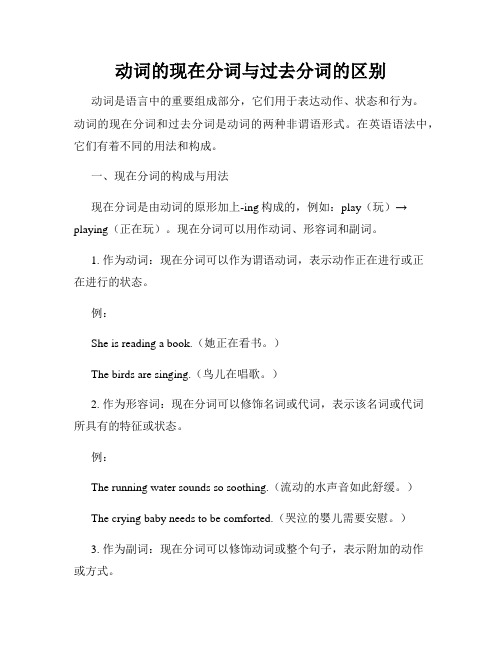
动词的现在分词与过去分词的区别动词是语言中的重要组成部分,它们用于表达动作、状态和行为。
动词的现在分词和过去分词是动词的两种非谓语形式。
在英语语法中,它们有着不同的用法和构成。
一、现在分词的构成与用法现在分词是由动词的原形加上-ing构成的,例如:play(玩)→ playing(正在玩)。
现在分词可以用作动词、形容词和副词。
1. 作为动词:现在分词可以作为谓语动词,表示动作正在进行或正在进行的状态。
例:She is reading a book.(她正在看书。
)The birds are singing.(鸟儿在唱歌。
)2. 作为形容词:现在分词可以修饰名词或代词,表示该名词或代词所具有的特征或状态。
例:The running water sounds so soothing.(流动的水声音如此舒缓。
)The crying baby needs to be comforted.(哭泣的婴儿需要安慰。
)3. 作为副词:现在分词可以修饰动词或整个句子,表示附加的动作或方式。
例:He came running to catch the bus.(他跑着过来赶公交车。
)Considering the circumstances, I think we made the right decision.(考虑到情况,我认为我们做出了正确的决定。
)二、过去分词的构成与用法过去分词是由动词的原形加上-ed、-d、-t、-en或常见的不规则变化形式构成的,例如:play(玩)→ played(玩过了)。
过去分词可以用作动词、形容词和副词。
1. 作为动词:过去分词可以表示过去的动作或状态,常与助动词have或be连用,构成完成时态或被动语态。
例:They have finished their homework.(他们完成了作业。
)The house was built in 1990.(房屋建于1990年。
)2. 作为形容词:过去分词可以修饰名词或代词,表示由该名词或代词引起的动作或状态。
现在分词与过去分词的区别

A. drink B. to drink C. drinking D. drunk
20.I appreciated ________ the opportunity to study abroad two years ago.
Not knowing what to do, he went to his parents for help.
由于不知如何办是好,他去找父母帮忙。
Smiling, they came in.
2)过去分词作状语时,过去分词表示的动作是句子主语承受的动作,它们之间的关系是被动关系。
9.He is an ________ teacher.
A. advancing B. advanced C. being advancing D. advance
10.________ exceptions, the rule may stand.
A. Allow for B. Allowing for C. To allow D.To allow for
Travelling is interesting but tiring.旅行是有趣的,但是使人疲劳。
The pupils will get confused if they are made to learn too much.
如果要学生学得太多,他们会感到糊涂的。
The game is exciting. (现在分词作表语)
8.The bank is reported in the local newspaper ________ in broad daylight yesterday.
- 1、下载文档前请自行甄别文档内容的完整性,平台不提供额外的编辑、内容补充、找答案等附加服务。
- 2、"仅部分预览"的文档,不可在线预览部分如存在完整性等问题,可反馈申请退款(可完整预览的文档不适用该条件!)。
- 3、如文档侵犯您的权益,请联系客服反馈,我们会尽快为您处理(人工客服工作时间:9:00-18:30)。
过去分词与现在分词的区别一、现在分词现在分词由动词加ing构成。
非谓语动词中的现在分词主要起形容词和副词的作用,在句中作定语、表语、补语或状语。
(一)、现在分词的两个基本特点。
1. 在时间上表示动作正在进行。
例如:a developing country. 一个发展中的国家,boiling water 沸水,rising sun 冉冉升起的太阳。
(试比较:a developed country 一个发达国家,boiled water 白开水,risen sun 升起的太阳)2. 在语态上表示主动。
例如:the ruling class 统治阶级,the exploiting class 剥削阶级。
(试比较:the ruled class 被统治阶级,the exploited class 被剥削阶级)(二)、掌握现在分词的基本功能。
1. 现在分词作定语,表示正在进行的或主动的动作。
也可以说明被修饰词的性质和特征,此时可换成相应的定语从句。
例如:①There was a terrible noise following the sudden burst of light.②He saw a flying bird and raised his bow.③I was satisfied with the exciting speech.2. 现在分词作状语时,可作时间、条件、结果、原因和伴随状语,表示正在进行的或主动的动作。
此时分词的逻辑主语就是主句的主语,因此要注意人称、时态和语态的一致性。
如:①The visiting minister expressed his satisfaction with the talks, adding that he had enjoyed his stay here.②European football is played in more than 80 countries, making it the most popular sport in the world.③Seeing from the top of the hill, we can find that the city looks more beautiful.3. 现在分词作补足语,表示正在进行的或主动的动作。
例如:①Soon they could see the steam rising from the wet clothes.②The missing boys were last seen playing near the river.4. 现在分词的独立主格结构作状语。
例如:①With his lips still trembling, he couldn't say a word.②“Mama! ”he cried suddenly, tears rolling down his cheeks. “妈妈!”他突然哭着喊,泪水从他的脸上流下来。
(这里需要用现在分词的独立主格结构tears rolling down his cheeks 作状语。
)③Weather permitting, we'll go to the Great wall. 如果天气允许的话,我们就去长城。
(这里需要用现在分词的独立主格结构Weather permitting 作状语。
)二、过去分词(一)、基本概念1. 分词的定义动词的-ed分词即过去分词,是由动词的过去分词构成,一般只有一种形式。
2. 过去分词的语法作用:过去分词一方面具有动词的性质,另一方面也相当于一个形容词或副词,在句中可以作表语、定语、状语和补足语。
过去分词一般有“被动”和“已经完成”两种含义。
如spoken English 中的spoken ,表示被动的动作;boiled water 中的boiled ,表示完成的动作。
1) 过去分词作表语,主要表示主语的心理感觉或所处的状态。
如:Don’t touch the glass because it is broken. 不要碰那个杯子,它是坏的。
She is quite pleased with the design of the dress. 她很喜欢那礼服的式样。
2) 过去分词做定语:单个的过去分词作定语一般放在名词的前面,相当于一个定语从句。
如:The excited people rushed into the building. 激动的人们奔进了大楼。
We need more qualified teachers. 我们需要更多合格的教师。
过去分词短语作定语通常放在被修饰的词后面,相当于一个定语从句。
如:Is there anything planned for tomorrow? 明天有什么活动吗?The suggestion made by the foreign expert was adopted by the manager. 外国专家提出来的建议被经理采纳了。
过去分词作定语也可用作非限制性定语,前后用逗号隔开。
如:The books, written by Lu Xun, are popular with many Chinese people.这些书是鲁迅写的,受到了许多中国人民的喜爱。
The meeting, attended by one thousand students, was a success. 这次会议获得很大的成功,共有一千个学生出席了。
3) 过去分词做状语:过去分词和-ing分词作状语一样,也可以表示时间、原因、条件、让步、方式或伴随情况等。
①表时间,相当于一个时间状语从句,有时过去分词前可加连词when或while来强调时间概念。
如:Seen from the top of the hill, the city looked like a big garden. 从山顶上看,这个城市就像一个大花园。
Accepted by the Party, he decided to devote his life to the cause of the Party.入党以后,他决定献身于党的事业。
②表原因,相当于一个原因状语从句。
如:Deeply moved by the story, the excited people stopped quarrelling with each other.激动的人们被那个故事深深地感动了,停止了争吵。
Encouraged by the speech, the young people made up their minds to take up the struggle.受到了讲演的鼓舞,年轻人决定起来从事斗争。
③表条件,相当于一个条件状语从句,有时过去分词前可用if等词。
如:Given another chance, he will do better.再给他一次机会,他会做得更好。
Compared with your brother, you should make greater efforts to study English.和你哥哥相比,你应该更加努力学习英语。
If heated, water can be turned into steam. 水如果被加热,会变成水蒸气。
④表让步,相当于一个though/although引导的让步状语从句。
如:Exhausted by the running, they went on running after the robber.尽管已经跑得筋疲力尽,他们还是继续追赶着那个强盗。
Laughed at by many people, he continued his study. 尽管被许多人嘲笑,他还是继续他的研究。
⑤表方式或伴随情况。
如:The old man went into the room, supported by his wife.那个老人在他妻子的搀扶下走进了房间Seated at the table, my father and I were talking about my job. 我和父亲坐在桌子旁边讨论着我的工作问题。
4) 过去分词作补足语:过去分词可以在see, hear, notice, watch, find, get, have, feel, make, leave, keep等词后与一名词或代词构成复合宾语,用作宾语补语。
如:When will you go to the hospital and have your tooth examined? 你什么时候去医院检查牙齿?When you are making a speech, you should speak louder to make yourself heard.当你在作报告时,你应该讲响一点使自己被人听清。
当这类句子变成被动语态时,过去分词用作主语补语。
如:One of the glasses was found broken. 有人发现其中一个杯子破了。
They should be kept informed of the situation there. 应该让他们知道那儿的形势。
(二)、特别提醒1.分词作状语时,它的逻辑主语一般必须和句子的主语相一致。
如:When asked why he came here, the boy kept silent.当那个男孩被问到为何来这里时,他沉默不语。
Living in the countryside, he was interested in biology.由于生活在农村,他对生物很感兴趣。
如果分词的逻辑主语和句子主语不一致,必须使用分词的独立主格结构。
2. 动词have后所接的三种宾语补语:have somebody/something do something 不定式作补语必须省去to, 不定式动作由宾语发出,表示一次性的动作。
如:I had the workers do the job for me. 我让工人们替我完成了工作。
Jim often has his father help him with his homework. 吉姆经常让他的父亲帮助做家庭作业。
have somebody /something doing something -ing分词作补语,分词动作也由宾语发出,强调动作的延续或正在进行。
如:They had the tractor working all the time. 他们让拖拉机一直工作着。
We won’t have the child talking to his mother like that. 我们不能让那个孩子那样对他的妈妈说话。
